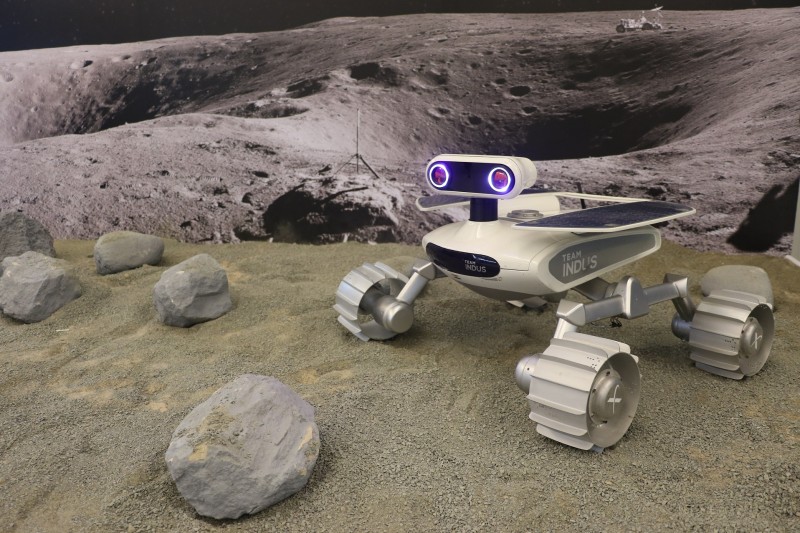The Yahsat Space Lab at Masdar Institute of Science and Technology hosted a workshop on how to build a lunar rover capable of exploring the moon’s rocky terrain, led by TeamIndus ‒ one of five teams competing for the Google Lunar XPRIZE.
 TeamIndus shared invaluable expertise as one of five finalist teams to receive verification and approval of their launch contract from the $30 million Google Lunar XPRIZE ‒ a competition to challenge and inspire engineers, entrepreneurs and innovators from around the world to develop low-cost methods of robotic space exploration. To win the Google Lunar XPRIZE, a privately funded team, such as TeamIndus, must be the first to successfully place a spacecraft on the moon’s surface, travel 500 metres, and transmit high-definition video and images back to earth.
TeamIndus shared invaluable expertise as one of five finalist teams to receive verification and approval of their launch contract from the $30 million Google Lunar XPRIZE ‒ a competition to challenge and inspire engineers, entrepreneurs and innovators from around the world to develop low-cost methods of robotic space exploration. To win the Google Lunar XPRIZE, a privately funded team, such as TeamIndus, must be the first to successfully place a spacecraft on the moon’s surface, travel 500 metres, and transmit high-definition video and images back to earth.
During the workshop at the Yahsat Space Lab, TeamIndus representatives taught 20 participants how to construct an exact replica of the advanced lunar rover their team plans to launch to the moon later this year. The participants included students from Masdar Institute’s Master’s concentration in space systems and technology, students from Khalifa University, and engineers from the Al Yah Satellite Communications Company (Yahsat) and the UAE Space Agency.
The workshop was held as part of an initiative titled ‘TeamIndus STEM Day @ Masdar Institute,’ and provided a hands-on learning opportunity to explore the technical aspects involved in assembling a functional robot with space applications.
“It was an honour to partner with TeamIndus to bring an educational and innovative workshop to Masdar Institute’s space systems and technology students,” said Mona Al Muhairi, chief human capital officer, Yahsat. “At Yahsat, we encourage initiatives that enhance outreach and inspire excitement and imagination in the hearts of our burgeoning scientists. We hope that through such efforts, we will contribute to the development of the next generation of Emirati engineers, who will have the passion and skills needed to achieve the nation’s space exploration goals.”
 “Our mission to the moon is not merely about landing on the lunar surface, but taking the world and the next generation in particular along with us on our journey. Space exploration is one of the few things that inspires all of humanity, no matter where they are. We live by the ideal that our Moon Mission can be a platform that inspires the next generation to aim higher than ever before. There are several programmes that we run with this underlying goal. And we’ve just started,” said Rahul Narayan, TeamIndus Fleet Commander.
“Our mission to the moon is not merely about landing on the lunar surface, but taking the world and the next generation in particular along with us on our journey. Space exploration is one of the few things that inspires all of humanity, no matter where they are. We live by the ideal that our Moon Mission can be a platform that inspires the next generation to aim higher than ever before. There are several programmes that we run with this underlying goal. And we’ve just started,” said Rahul Narayan, TeamIndus Fleet Commander.
The one-day workshop was divided into three sessions, with each session building towards the final construction of a model of the TeamIndus lunar rover. The day culminated in the testing of the group’s lunar rover on a terrain specifically developed for the rover in the Yahsat Lab.
“Designing and building a rover to traverse the moon is very challenging considering the harsh environment of the lunar surface. Every component has to be meticulously designed and rigorously tested. This workshop provided an excellent opportunity to learn about the design of robotic systems for space applications through insights of the challenges involved,” said Dr. Saif Almheiri, assistant professor, Mechanical and Materials Engineering.
The workshop was held one day after Masdar Institute’s CubeSat development program, MYSAT-1, completed its critical design review (CDR), which marks the final stage in the review process and is an important milestone for the space systems and technology concentration. The concentration was designed by faculty from Masdar Institute which is part of the Khalifa University of Science and Technology, with support from Yahsat and Orbital ATK – a global aerospace manufacturer and defense industry leader. The CDR review panel included experts from TeamIndus, Orbital ATK, Yahsat and the UAE Space Agency. Full-scale fabrication of the MYSAT-1 will now begin.





